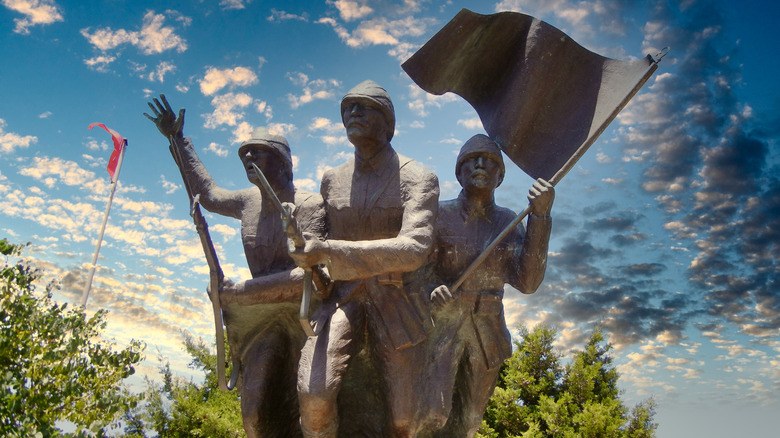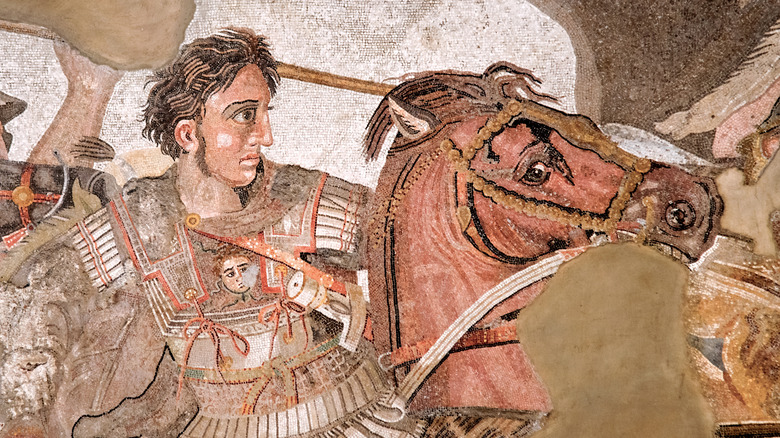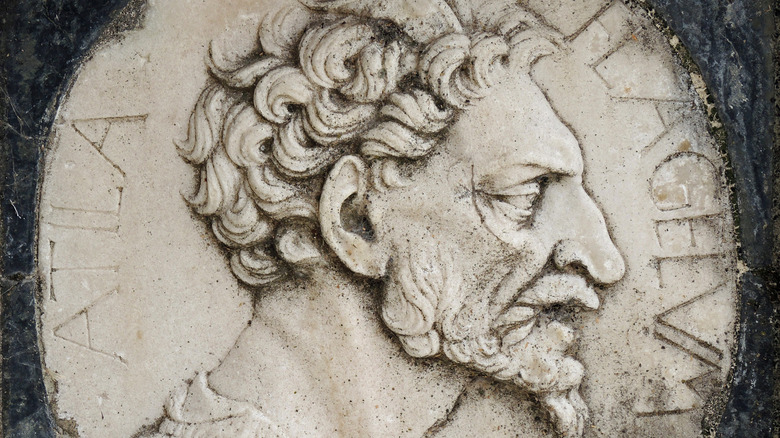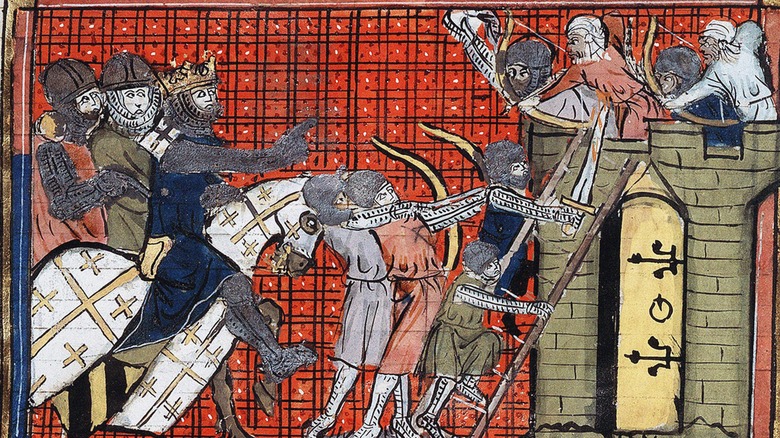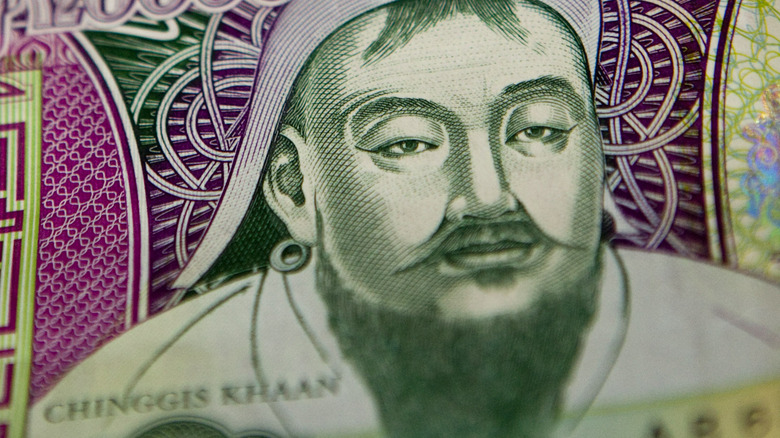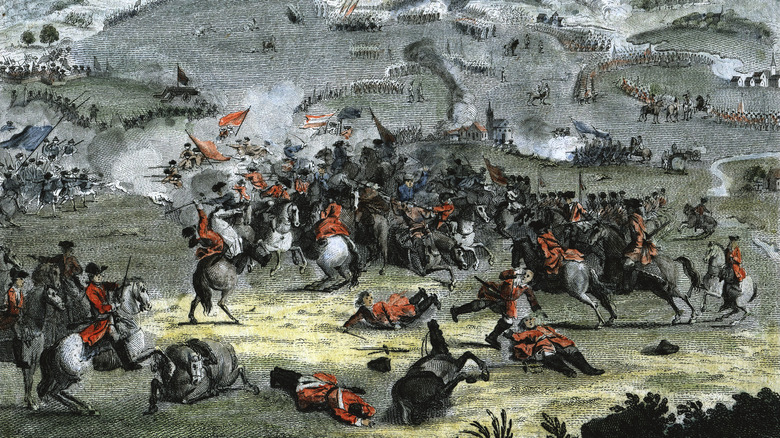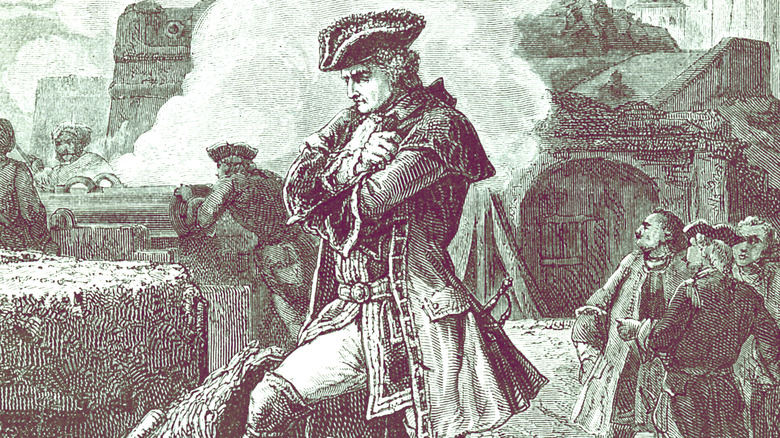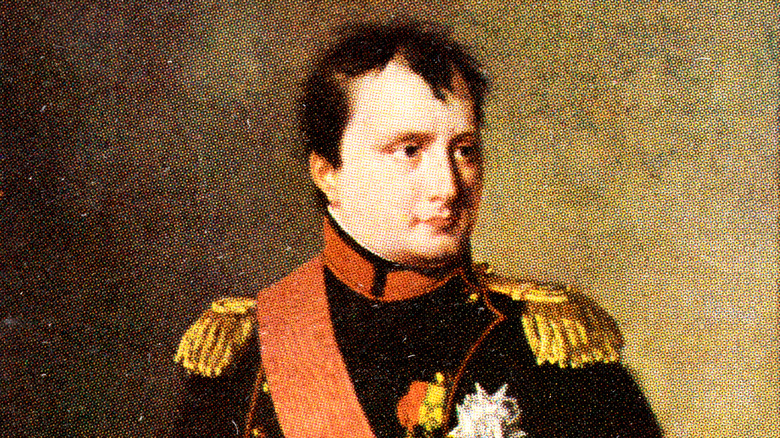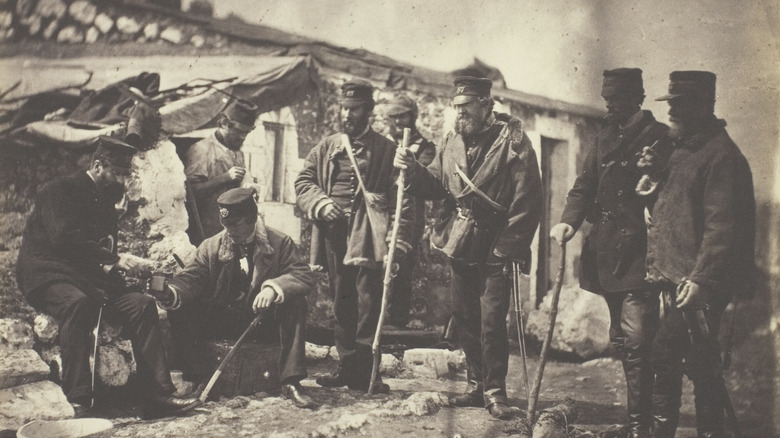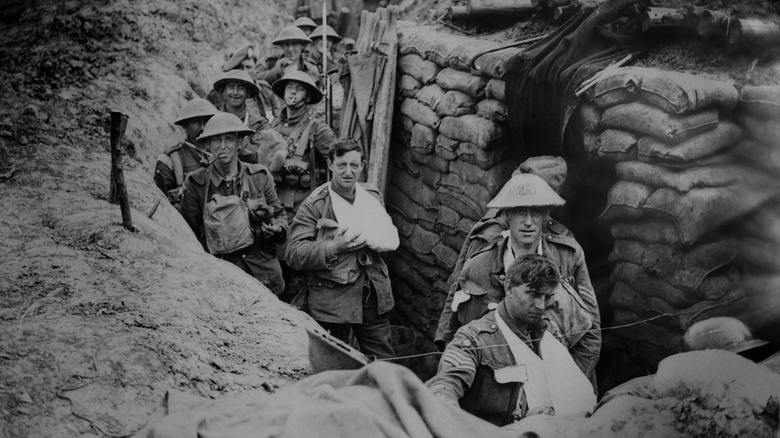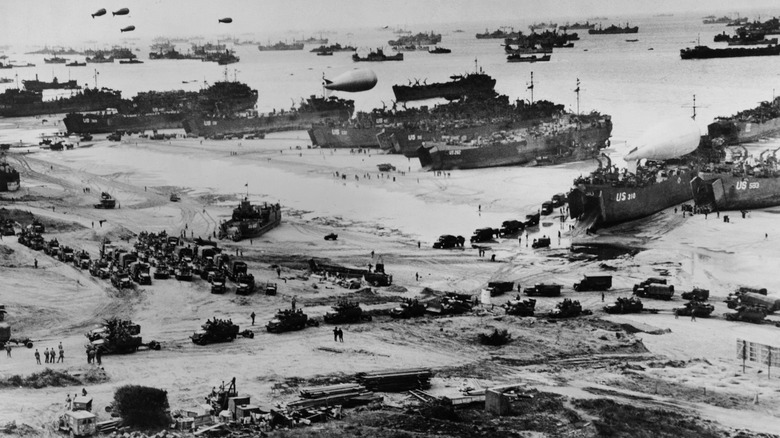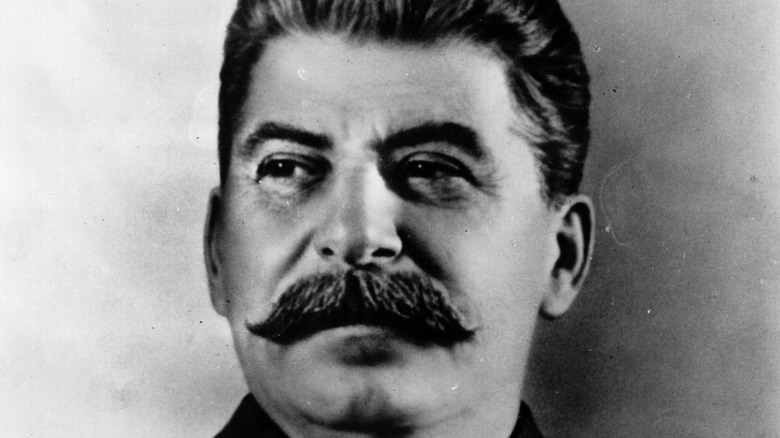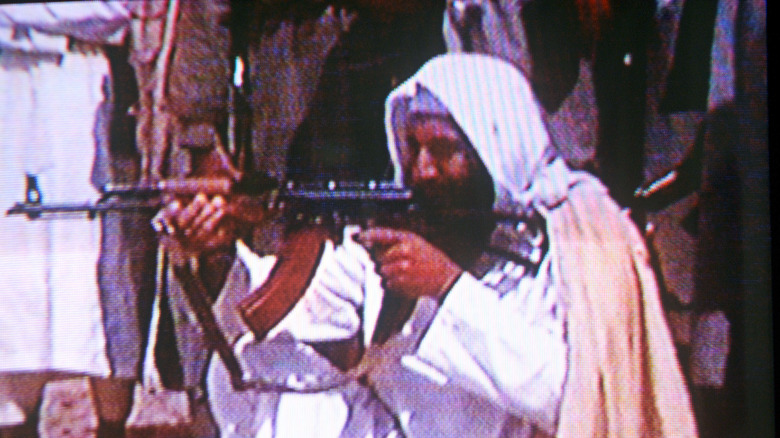How Many World Wars Have There Actually Been?
When asked how many world wars there have been, most people will answer "two." And that's correct by the basic metrics, namely the fact that only two of history's conflicts are officially called world wars: World War I and World War II (WWI and WWII for short), a pair of savage conflagrations separated by merely two decades. When you eschew the titular semantics, however, you find a host of wars throughout recorded history that very much count as world wars when viewed in their own context.
According to the Merriam-Webster Dictionary, a "world war" is "a war engaged in by all or most of the principal nations of the world." That's a bit reductive, as it tacitly excludes multiple nations relegated to non-principal status, and it also ignores the fact that wars — especially world wars — have major implications for states and people that may not be directly engaging in the fighting efforts in traditional ways.
Perhaps the best definition of a "world war," then, is a conflict that not only involves myriad parties and large swaths of land, but a conflict that has lasting implications that spread far and wide. Or to put it more succinctly, world wars are those clashes of arms that end up altering the course of human history. By that definition, there have been many, many more world wars than those two called out from the first half of the 20th century.
Wars of Alexander the Great
Before his death in the year 323 B.C. at a mere 32 years of age, according to Biography, Macedonian ruler Alexander the Great would continue a series of military campaigns commenced by his father, King Phillip of Macedon, that spread the borders of his empire across much of the world known to Alexander and his people. From its heartland at the north of Ancient Greece, at its greatest extent, the Macedonian Empire would spread across lands that encompass most of modern Greece, parts of Egypt, most of present-day Turkey, most of the Middle Eastern and Central Asian lands of Iraq, Iran, Jordan, Israel, Palestine, Syria, Pakistan, and it encroached into modern India, via Khan Academy.
The Wars of Alexander the Great consisted of a number of long engagements punctuated by four great battles, according to History Net. Following a few minor engagements to suppress revolts and shore up his power in the wake of his father's death, Alexander set out on the campaigns that would define most of his brief but eventful life: his wars against the Persian Empire. From 334 B.C. and continuing for the next 11 years, per History, Alexander was in near constant conflict with his Persian adversaries, the warfare ending with the once mighty Persian Empire largely defeated and absorbed by the victorious Macedonian Greeks. Alexander would then launch an ill-fated foray into India, though that doesn't fall into this world war purview. For battling across three continents with armies numbering in the tens of thousands, as told by National Geographic, and for engaging with multiple civilizations, the multi-year campaigns of Alexander the Great entirely meet the requirements for world war terminology.
Campaigns of Attila the Hun
Attila the Hun's campaigns came during the twilight years of a notable empire — indeed his wars weakened Rome and helped speed the collapse, per Live Science – and his Hunnic followers were primarily a nomadic people operating without a set homebase.
Attila the Hun was in power for only a brief number of years, his rule spanning less than two decades, having commenced in 434 A.D. and ending with his death in 453 A.D., per World History. During those years, however, Attila managed to carve out a massive, if short-lived, empire that spanned from across modern Germany in the northwest down to the shores of the Black Sea in the south and extended eastward well into present-day Russia, via Radio Lemberg. Upon taking over leadership of Huns, Attila launched a series of campaigns against the Romans that saw him sack many cities in the Eastern Roman Empire, having ravaged much of the Balkans on his way to those battles. He would next surge farther to the north and west, invading present-day France where, according to History, an alliance of Roman and barbarian troops stopped the Huns. Undeterred, Attila and his warriors returned to norther Italy and did more raiding and sacking there, before finally withdrawing to land on the Great Hungarian Plain — territory well within their new empire's borders.
Despite warfare having defined his life, Attila didn't die in combat; he choked to death on his own blood after an artery ruptured as he was abed on one of his many wedding nights, according to Smithsonian Magazine.
The Early Muslim Conquests
The year 622 A.D. marks the founding year of Islam, the religion's official start with Muhammad's forced flight from Mecca to Medina in that year, per Britannica. By the year 661 A.D., less than four decades later, and less than three decades after the death of the prophet Muhammad, Muslim warriors had taken land that spanned across much of northern Africa, the entirety of the Arabian Peninsula, and reached well into the Middle East and Central Asia, as told by Students of History. And within another century, Muslim conquests had spread out to almost the entire Iberian Peninsula and even into what is today southern France, the whole of North Africa, and as far east as present-day Pakistan.
But staying focused on the campaigns commenced during the prophet's lifetime and that were continued under his first four successors, the warriors of Islam spread their new religion across tens of thousands of square miles and engulfed myriad cultures in an amazingly efficient manner (via Khan Academy). They conquered societies spread out across the Arabian Peninsula, throughout the modern Middle East, took much of Egypt and modern Libya, and laid the foundations of a caliphate that would endure for centuries. The warfare during this two-decade period, called the Rashidun, according to Britannica, was as notable for its successful conquering of new lands and its spread of the religion of Islam to new peoples as it was for the peace and general cordiality that followed.
The Crusades
From their inception in the autumn of the year 1095 until the last of the so-called Crusades had come to an end nearly 200 years later in 1271, per History, this long series of campaigns and battles met just about every mark for a world war. The Crusades embroiled numerous principal nations of the day, cost huge amounts of blood and treasure, and undeniably altered the course of human history.
The germ of the First Crusade came from a plea for help sent to Pope Urban II from Byzantine emperor Alexius I whose lands were being besieged by Muslim Seljuk Turks. In the first instance of what would become standard operating procedure for the Crusades, the pope pivoted the focus of the coming campaign to be largely about liberation of the Holy Land, with support for the Byzantines a secondary goal that was almost lost in the ensuing action anyway, the western European knights and their followers soon at odds with their supposed allies of the east.
All told, Crusade warfare would ensnarl huge swaths of land, explains Utah State University – including most of modern Israel — see battles fought in myriad locations across the Middle East and well into Europe, and have aims spiraling well beyond the re-taking of the Holy Land or the aid of fellow Christians. There were Crusades waged against Jews in the Rhineland and against so-called heretics and Pagans in France and the Baltic lands, respectively, and the Crusades would ultimately end with the holy city of Jerusalem back in Muslim control, despite generations of warring.
The Mongol Conquests
It is difficult to overstate just how immense and powerful the Mongol Empire was, with the difficulty only compounded by the rapidity with which the empire came into being – at its greatest extent, the Mongol Empire covered the most contiguous land of any empire, nation, or federation of states known to history, according to National Geographic. And that's the case despite the fact that, whereas empires like those or Persia or Rome took centuries to expand to their largest range, the Mongols captured land reaching from the eastern shores of Asia well into Europe in a matter of decades.
The Mongol Empire was founded by Genghis Khan in the year 1206, with the capable ruler building on the work started by the unification of a handful of nomadic tribes native to the traditional Mongol homelands on the steppes of north-central Asia (noted in World History Encyclopedia). While the Mongol Empire is recognized to have lasted until the year 1368, after which infighting among fractious contenders for power — so-called rival khanates — the years during which Genghis Khan led the Mongols are those most aptly considered as a world war.
Genghis Khan ruled from 1206, as noted, until his death in 1227, per Encyclopedia. During those years, he first led successful battles against the Jurchen Jin Dynasty of northern China, then against the states of Xi Xia and the Song Dynasty, also both in China, according to the World History Encyclopedia. Much of China (and even parts of modern Korea) subdued, Genghis Khan and his Mongols turned west, conquering lands well into Central Asia and the Middle East, upending the balance for Christian and Muslim lands alike.
War of the Spanish Succession
The causes of — or perhaps, more accurately, the attempted justifications for — the War of the Spanish Succession are so arcane and complex that they can't well be explained in the time or space here, so suffice it to say that, when the Spanish king Charles II died in 1700 without having issued a child, per Britannica, it created a power vacuum into which very many parties wanted to surge. As claimants to the Spanish throne and the control of the Spanish empire it promised began to jockey, nations ranging from England to the Netherlands to Prussia to France to Portugal would be drawn into the fighting (and that's to say nothing of the grayer areas of lineages drawn in, like the Habsburgs or Savoys or Bourbons) (via National Army Museum).
Fighting, which would take place intermittently between the years 1701 and 1714, occurred all around the globe, making this rather odd and confusing war very much a world war. Battles would take place all across Europe, from the Iberian Peninsula to the Low Countries to Italy (noted in Britannica); war was even waged in North America across eastern seaboard of modern America (via ThoughtCo).
According to Britannica, the long war ended with the Treaties of Utrecht, a series of negotiations as complicated as the machinations that led to war in the first place, with titles and lands shifting about and separate peaces formed between myriad parties.
The Seven Years' War
There are arguably two things about the Seven Years' War, also called the French and Indian War when discussing the North American aspects (and viewed through an American lens): the first is that it was very much a world war, per the Department of State, with combat raging not only on both sides of the Atlantic Ocean, but also in the Caribbean, in India, in the Philippines, and in Africa (per History). The second is the fact that it would be the last major war fought before the world order was changed by two major revolutions and new ensuing notions of statehood: within a few short decades following the 1763 conclusion of the Seven Years' War, the United States of America would emerge following victory in the American Revolution, while France would be transformed following years of revolution and the ensuing Napoleonic Wars.
The war started when Austrian Habsburgs tried to seize the territory of Silesia from Prussia, an action which drew in France, Saxony, Sweden, and Russia on the French side and embroiled England as an ally of the Prussians (as shared by Britannica). Given the far-flung colonial holdings of many of the belligerents, it's no surprise the combat was a global affair. Matching in scope of the land involved were the numbers of soldiers involved, which in some battles numbered well over 100,000 total.
Also notable about this world war? The fact that at its conclusion, almost nothing changed in Europe, while in North America a few swaths of land changed hands: the peace settlements that ended the Seven Years' War essentially returned everything to a pre-war status quo, though France did lose a fair amount of territory in North America (via History).
The Napoleonic Wars
From out of the horrific charnel house that was the French Revolution emerged a powerful state led by a powerful man who briefly challenged — and defeated — much of the world. That man was, of course, Napoleon Bonaparte, one of the few individuals from history influential enough to have his or her name used to define an entire series of wars. Sure, there are the Punic Wars or Persian and so forth, which are named for a civilization therein involved, but a series of wars named for a man? That's a true rarity. What was less rare about the Napoleonic Wars is that, like so often happened before and after this series of campaigns and battles lasting from 1803 to 1815, per the Department of State, their territorial scope grew wider and wider and their foundational goals grew, eventually spinning out of control.
Napoleon took power in 1799 after toppling the government that had seized power by toppling the monarchy during the French Revolution. He spent a few short years shoring up power with a few European campaigns (as well as a failure to stop a revolt in Haiti and the selling off of territory to America in the Louisiana Purchase, per Britannica) before becoming embroiled in war with Great Britain in 1803, thus launching the proper Napoleonic Wars.
These series of wars would spread across Europe, well into Russia — site of one of the general-cum-emperor's few major defeats — and from South America to Africa to the North Sea, per History of War. Dozens of nations and royal houses would be drawn into the wars, which ended only with Napoleon's final defeat and second exile in 1815, per History.
The Crimean War
Control of the Crimean Peninsula has always been important and has always been a source of strife. The controllers of this vital piece of land hold much of the sway over the Black Sea, and thus largely control central European and west Asian access to the Mediterranean Sea, the Atlantic Ocean beyond it, and by extension, global sea trade and travel. And in the year 1853, a war broke out that was largely predicated on control of said peninsula, but that saw action and implications so far beyond it that the Crimean War can fairly be called a world war.
According to History, the immediate causes of the Crimean War was Russian occupation of the Turkish-controlled states of Walachia and Moldavia, actions the Russian czar Nicholas I predicated on a Turkish refusal to recognize special Russian status as protector of Orthodox Christians in Turkic lands. The Turks countered the occupations and declared war, yet soon found themselves outgunned by the Russians in a savage sea battle. Britain and France joined Turkey to fight against Russia, and soon a larger war was enjoined that would ultimately see some 650,000 soldiers killed, per History. And while most of the intense fighting did take place on the strategically vital Crimean Peninsula itself — such as the famed, ill-fated "Charge of the Light Brigade" celebrated in Alfred Lord Tennyson's poem (via Britannica) — combat also took place in the Balkans, the White Sea, and as far off as the Pacific Ocean, per the Warfare History Network.
The largely inconclusive settlement of the war inspired the Russians to attempt a rapid and largely ham-fisted modernization while Austria broke traditional ties with Russia and subsequently, found itself weakened (via Britannica).
The Great War
Call it what you will, The Great War, The War to End All Wars, or the First World War, and you'll be getting it wrong; it was not great, it did not end war, and it was hardly the first global war. But it was the deadliest global war humanity had yet inflicted on itself, and one filled with firsts beyond its inaccurate name. WWI was the first war in which aircraft played a direct combat role, as noted by United Press International. It was the first war in which tanks took to the battlefield, as noted by Popular Mechanics. Horrifically, History reports how it was the first war in which chemical weapons were actively and regularly deployed. And it was the first modern war in which civilians and civilian infrastructure were counted as in bounds by the belligerents, as relayed in My Learning.
The war pitted the powerful and aggressive German state, allied with the Austro-Hungarian and Ottoman Empires (and with Italy, briefly) against Great Britain, France, Russia, Belgium, and many others, including America after its late entry into the fracas in 1917 (via Britannica). While most of the fighting took place on the western and eastern fronts in Europe, WWI also saw battles fought in parts of Africa, in eastern Asia, on Pacific islands, and on waters as spread out as the Indian Ocean to the North and South Atlantic to the Mediterranean and beyond.
The Great War resulted in nearly 20 millions deaths, with more than that again wounded, according to Reperes. The majority of the deaths noted were not combatants, but were civilians. And when the war ended in November of 1918, it did so with a treaty so reviled by the defeated Germans it was all but assured war would come again soon. Which it did.
World War II
If WWI was "The War to End All Wars," then WWII really should have been "The War That Actually Ended All Wars." As evidence, refer to a quote often attributed to Albert Einstein: "I do not know with what weapons World War III will be fought, but World War IV will be fought with sticks and stones." Though dubious if the famed scientist really said this, via Snopes, the wisdom rings true: the world simply could not handle a war more awful than the Second World War, not given the super weapons that emerged from that conflict, namely the atomic bomb.
World War II saw combat reach almost every corner of the globe, and wherever it did not take place, it readily could have. This is due to the ever longer range of aircraft, submarines, and surface ships, the introduction of ballistic missiles. The mighty, aggressive, and advanced armies of Germany and Japan (and the mighty navy, in the latter case) crushed and conquered huge swaths of land in record time. On top of that, ideology clouded humanity, paving the way for levels of cruelty and violence never before witnessed on anything like the mass scale reached between the years of 1939 and 1945, via Library of Congress.
Tens of millions of soldiers and civilians died, combat raged all across Europe and the Pacific, in much of Africa, and even on North American territory. Combat raged at sea and in the air. And when the shooting stopped, the world was forever changed in ways still entirely at play today.
The Cold War
It's called the Cold War because it never got hot, so to speak, as far as the principal players were involved. That's to say that the United States and its NATO allies never got into a direct war with the Soviet Union and its Warsaw Pact allies (via NATO). But just because a shooting war between the Soviets and the major Western powers never commenced hardly means the Cold War was bloodless. Instead, both sides backed other nations time and again in a series of engagements that sometimes stopped with threats and attempts at brinksmanship, as with the Cuban Missile Crisis, and at other times saw violent proxy wars fought.
The best known Cold War wars that indirectly pitted the USSR against the west were the Korean War (via National Geographic), the Congo Crisis (via Atomic Heritage), the Vietnam War, and the Soviet invasion of Afghanistan (via Harvard's Belfer Center), to name just a few. Tens of thousands of lives were lost in these and other conflicts waged in the course of greater geopolitical jockeying during the Cold War years, which can be said to have spanned from the end of WWII in 1945 until the final dissolution of the Union of Soviet Socialist Republics in 1991, per National Geographic. Though as current events show, in many ways, all that has changed are the names of nations, not the aims they have for ever greater power, influence, or outright control of as much territory, treasure, and humanity as can be had.
The War on Terror
Declaring a war on a concept is a pretty good way to ensure you lose that war. The so-called Global War on Terror was declared following the terrorist attacks on America that took place on September 11, 2001, and would be used as part of the justification for invasions of Afghanistan and Iraq; for drone strikes in countries like Libya and Syria, as reported by the New York Times; for raids in Pakistan, such as the dramatic Navy SEAL operation that led to the death of Osama bin Laden, as reported on by NPR; for broad domestic surveillance of American citizens (via ACLU); for "enhanced" interrogation techniques tantamount to torture used against suspected terrorists, and on it has gone, per Brookings.
The hard thing to fathom about the Global War on Terror is the fact that, without a distinct adversary, there can never be a final victory in the form of military defeat or a surrender. Even were one terror group to renounce violence, there would be so many more still out there ready to inflict pain and suffering on perceived enemies. Even the gray area of the Cold War was clear compared to the murkiness of the War on Terror. In fact, the only way to end this so-called "war" would be for the military and political leaders so associated with its efforts to formally agree to cease referring to it as such and adopt different methods.
As well-meaning as those who declared the War on Terror may have been, the efforts by America and its allies have been largely in vain, per The Intercept. Iraq had no WMD program, states the Washington Post. Afghanistan is back in Taliban hands, per CFR. Syria is a shattered nation, per the New York Times. And on it goes.
